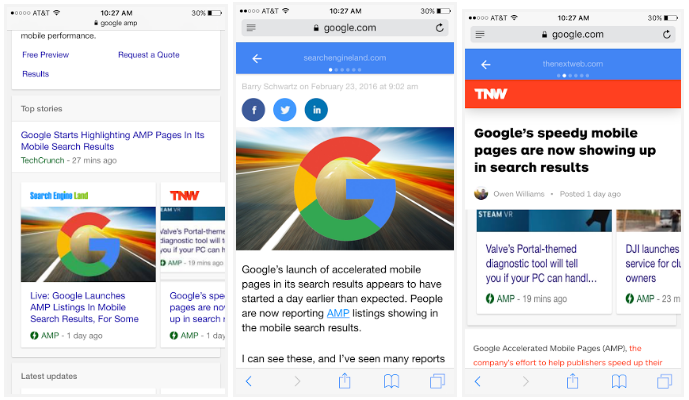What’s new with the Google AMP Project?
When the AMP Project was announced, Google hinted at a future iteration which would involve eCommerce solutions, and that time has come. As of August 22, 2016, the framework is now suitable to build aspects of eCommerce sites - specifically category and product pages. (source) Want to learn more about the first release of AMP? Jump to Background on the Google AMP Project.
Want to see for yourself? As of August 24, Seer has been unable to trigger an AMP eCommerce result in Google Search. On a mobile device you can use http://g.co/ampdemo to try to trigger AMP results (h/t Kavit Shah). The query that has worked for us has been “ebay skateboards” (h/t Onur Ozcan).

Search Engine Results Page with Amp Results

AMP Category Page
What do eCommerce site owners need to know?
It's all about mobile site speed & experience
- While Google has stated that AMP pages aren’t a benefit to ranking in itself, mobile site speed and experience is, so the two are likely to go hand-in-hand.
- In a separate announcement, Google stated that 85% of results are mobile friendly, leading to the decision to remove the “Mobile Friendly” tag to keep the SERPs uncluttered (source). The AMP label will soon take its place.
- On the heels of this update came another mobile announcement from Google, highlighting an impending update which will devalue pages where content is not easily accessible to users due to obtrusive popups and standalone interstitials (source).
- While Product and Category pages are eligible to convert into AMP pages, pages within the purchase flow will exist as they currently do on mobile devices.
- eBay, an early adopter, has launched around 8 million AMP pages (source).
Limited design customization & analytics tracking - for now
- Site owners have limited control over design and customization of these AMP pages. They will look more like a Google Search feature and less like your current site.
- Limited analytics can be configured through amp-analytics on many platforms, but for many, including early adopter eBay, there’s much still to be developed to handle robust analytics on AMP pages (source).
- Google Analytics currently recommends setting up a separate property for AMP measurement (source). However since purchase flow will not be in AMP pages, some level of cross-tracking will be needed to get the full view of the customer journey and will need testing.
What do eCommerce site owners need to do?
- Check Google Search Console for any AMP-related messages for further information
- Review the Getting Started Blog Post from the AMP Project
- Benchmark current mobile traffic and rankings to category and product pages
- Be on alert for competitors implementing AMP
What is Seer’s POV on this update?
- This update could level the playing field for smaller, more agile sites to quickly implement AMP pages and see an increase in mobile visibility
- At a minimum, all eCommerce sites should investigate options for testing AMP product and category pages to assess potential business impact
- AMP appears to be replacing the beta version of JSON-LD for ecommerce integration, which means AMP adoption could be a scalable solution for implementing schema markup on some eCommerce mobile sites (source)
- Anyone planning to develop their own AMP pages should include budget for developing a tracking strategy and assess and mitigate risks of data loss with use of AMP pages in the purchase process. Tracking is critical to evaluate AMP page performance.
Next Steps
- Given the connection to schema markup, Seer is looking into additional benefits of implementing AMP pages beyond site speed and user experience. Check back for updates on this next month!
- Seer is assessing potential impact and next steps on a client-by-client basis and we recommend you do the same. Reach out to your Seer Account Manager for more information. If you don’t have one of those, here’s how to get one.
- Seer is testing integrating AMP tracking with Universal Google Analytics and will provide updates on findings via our Blog.
What is the Google AMP Project?
The Accelerated Mobile Pages (AMP) Project is an initiative by Google to “speed up the web”. It is a way to build static content that renders pages fast.
The idea is for web pages to have identical versions built with a lightweight HTML framework so that pages load instantously. The way it works is by using a open source code led by Google that strips out all unnecessary code that detracts from performance.
- AMP Project
- Google Announces Launch of AMP
- How AMP is going to affect the mobile web
- Google Analytics Support for AMP
- Seer’s Initial POV on AMP
What did it look like?

The Google AMP Carousel has been a feature present in mobile search since February. It’s front and center in mobile SERPs. While Google has previously hinted that their plan is to adapt the AMP project to all types of websites, previously it’s only impacted content publishers.
Quick Facts
- If you implement AMP pages, you must also re-implement Google Analytics on the AMP pages or you will lose tracking.
- It's recommended to use a separate Google Analytics Property for AMP pages. This mitigates potential conflicts with your existing website tracking, where if tracked together, could cause single visitors to be tracked twice to HTML and AMP versions of pages.
- Traditional methods of deploying Google Analytics tracking (including Google Tag Manager) will not work; a brand new set of code is required.
- Converting to Google AMP pages isn’t a ranking signal in itself. However, if you’re migrating from a poor mobile experience to Google AMP pages, you should expect increased visibility in mobile search.
- Being listed in the Google AMP Carousel could be both a threat and an opportunity in itself. The platform entices users to scan through all available articles, making it unlikely to attract users to click through to other content or engage with any calls to action.
- One known reason for greater adoption of ad blocking tools by searchers has been the impact ads have had on site speed. Converting to Google AMP pages may reduce ad blocking tool usage and could result in increased ad impressions over time.
Additional Resources
- https://www.ampproject.org/docs/guides/discovery.html
- http://searchengineland.com/get-started-accelerated-mobile-pages-amp-240688
- https://amphtml.wordpress.com/2016/08/22/getting-started-with-amp-for-e-commerce/
- https://www.seerinteractive.com/blog/google-accelerated-mobile-pages-amp-worth-marketers-time/
- https://developers.google.com/analytics/devguides/collection/amp-analytics/


